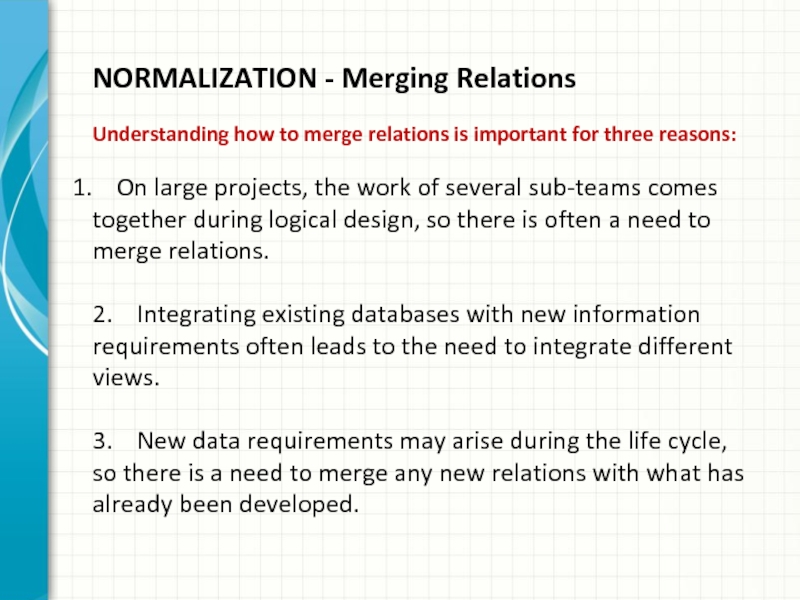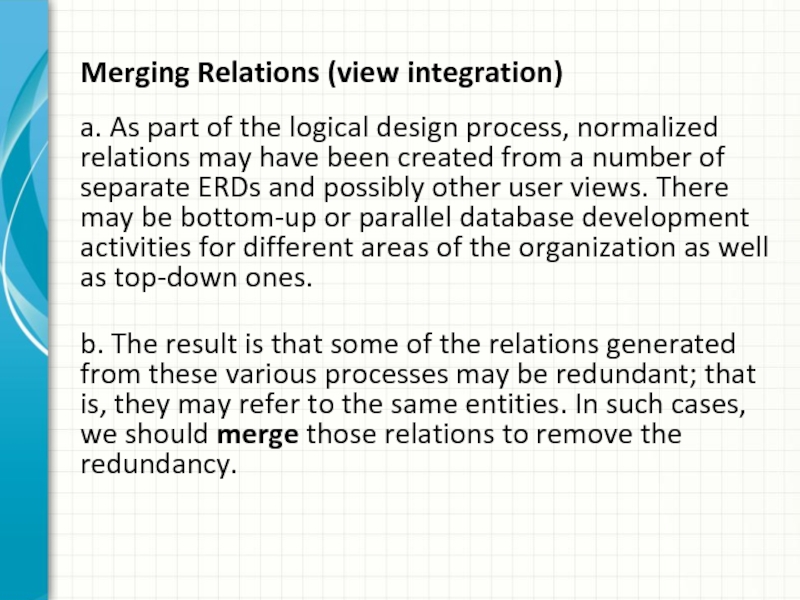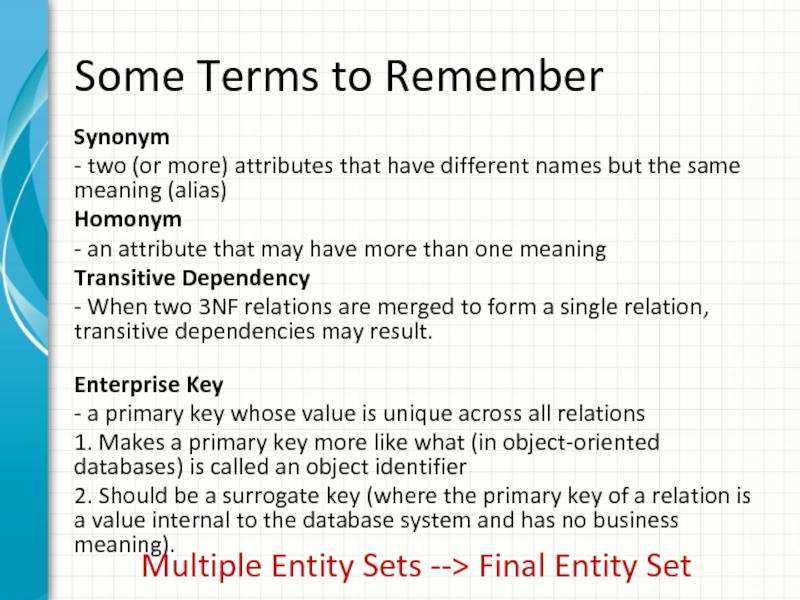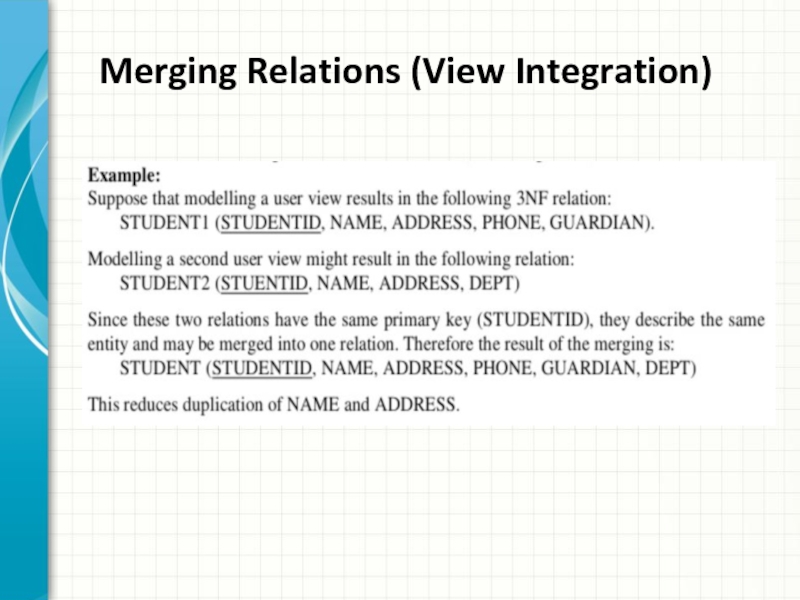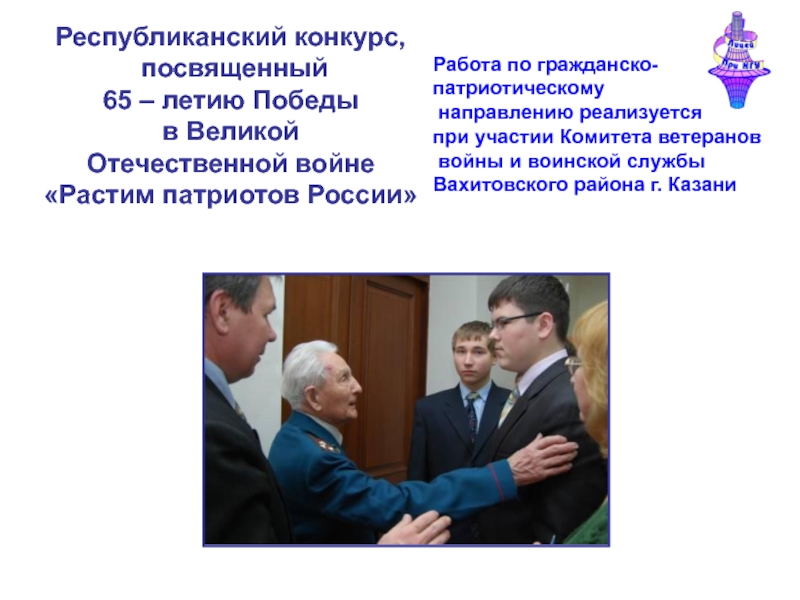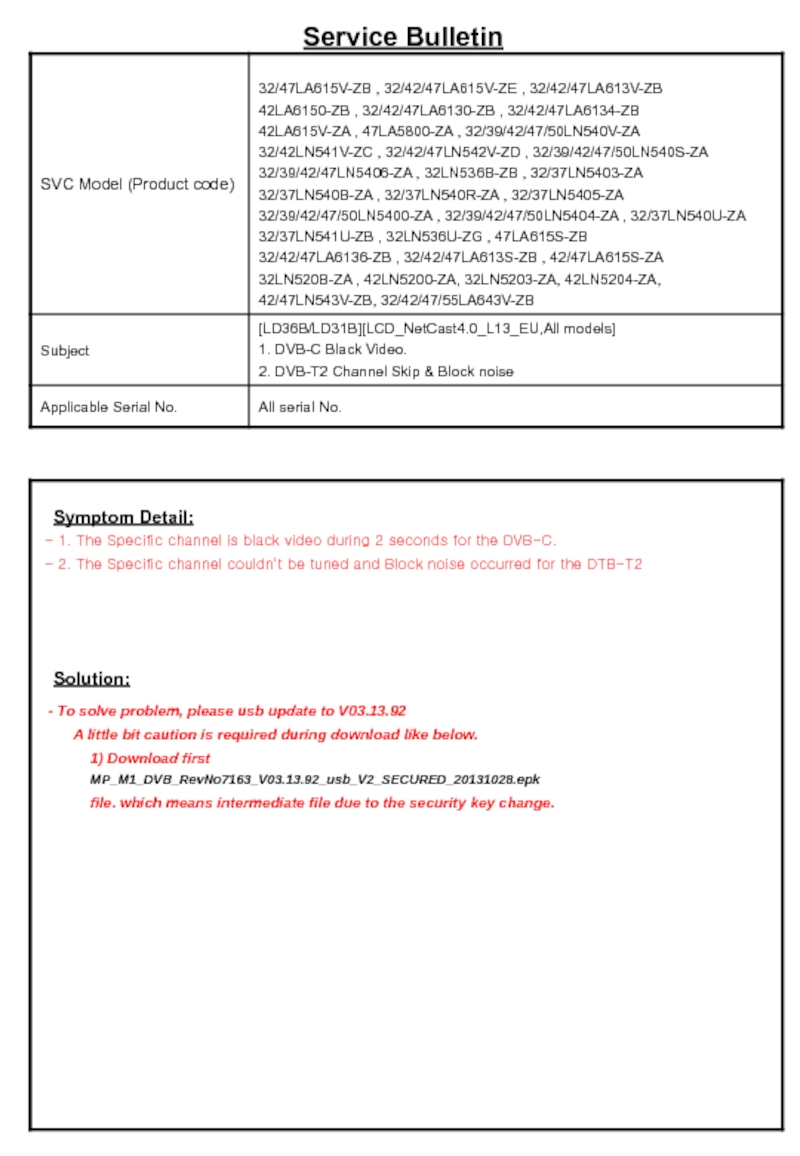- Главная
- Разное
- Дизайн
- Бизнес и предпринимательство
- Аналитика
- Образование
- Развлечения
- Красота и здоровье
- Финансы
- Государство
- Путешествия
- Спорт
- Недвижимость
- Армия
- Графика
- Культурология
- Еда и кулинария
- Лингвистика
- Английский язык
- Астрономия
- Алгебра
- Биология
- География
- Детские презентации
- Информатика
- История
- Литература
- Маркетинг
- Математика
- Медицина
- Менеджмент
- Музыка
- МХК
- Немецкий язык
- ОБЖ
- Обществознание
- Окружающий мир
- Педагогика
- Русский язык
- Технология
- Физика
- Философия
- Химия
- Шаблоны, картинки для презентаций
- Экология
- Экономика
- Юриспруденция
Lecture 11. Even more normalization презентация
Содержание
- 1. Lecture 11. Even more normalization
- 2. Agenda: Foreign Keys FK Example: Customer
- 3. Foreign Keys Support “1-to-Many” Relationships
- 4. Example
- 5. Three ways to detect a Foreign Key
- 6. Normalization Example: ABC PRINTER COMPANY
- 7. Normalization Example: ABC PRINTER COMPANY
- 8. Normalization Example: ABC PRINTER COMPANY
- 9. Normalization Example: ABC PRINTER COMPANY
- 10. Normalization Example: ABC PRINTER COMPANY
- 11. NORMALIZATION - Merging Relations Understanding how
- 12. Merging Relations (view integration) a.
- 13. Some Terms to Remember Synonym -
- 14. Merging Relations (View Integration)
Слайд 2Agenda:
Foreign Keys
FK Example: Customer and Sales Rep
3. Three ways
to detect a Foreign Key
4. Normalization Example
5. A first-look at Merging Relations
4. Normalization Example
5. A first-look at Merging Relations
Слайд 3Foreign Keys Support
“1-to-Many” Relationships
Foreign Keys Are Used to Look Up
Information in another relation
Слайд 5Three ways to detect a Foreign Key
1. A FK occurs when
removing a transitive relation from a 2NF relation.
2. Look at an ERD diagram. Every time there is a 1:M relationship and relational integrity is enforced, it means there is a FK. The Foreign Key is on the relation which is on the Many side of the One-to-Many relationship.
3. Examine all tables in the 3NF solution. If the Primary Key of a relation is present in a second relation, then that attribute in the second relation is a Foreign Key.
* Foreign keys can be made of attributes that are part of the PK as well as non-key attributes.
2. Look at an ERD diagram. Every time there is a 1:M relationship and relational integrity is enforced, it means there is a FK. The Foreign Key is on the relation which is on the Many side of the One-to-Many relationship.
3. Examine all tables in the 3NF solution. If the Primary Key of a relation is present in a second relation, then that attribute in the second relation is a Foreign Key.
* Foreign keys can be made of attributes that are part of the PK as well as non-key attributes.
Слайд 7Normalization Example:
ABC PRINTER COMPANY
UNF: [ model#, modelDesc, (part#, part_name, qty, suppName,
suppPhone, unitPrice) ]
Слайд 8Normalization Example:
ABC PRINTER COMPANY
UNF: [ model#, modelDesc, (part#, part_name, qty, suppName,
suppPhone, unitPrice) ]
1NF: MODEL [ model#, modelDesc ]
MODEL_PART [ model#, part#, part_name, qty, suppName, suppPhone, unitPrice) ]
1NF: MODEL [ model#, modelDesc ]
MODEL_PART [ model#, part#, part_name, qty, suppName, suppPhone, unitPrice) ]
Слайд 9Normalization Example:
ABC PRINTER COMPANY
UNF: [ model#, modelDesc, (part#, part_name, qty, suppName,
suppPhone, unitPrice) ]
1NF: MODEL [ model#, modelDesc ]
MODEL_PART [ model#, part#, part_name, qty, suppName, suppPhone, unitPrice) ]
2NF: MODEL [ model#, modelDesc ]
PART [ part#, part_name, unitPrice ]
MODEL_PART [ model#, part#, qty, suppName, suppPhone ]
1NF: MODEL [ model#, modelDesc ]
MODEL_PART [ model#, part#, part_name, qty, suppName, suppPhone, unitPrice) ]
2NF: MODEL [ model#, modelDesc ]
PART [ part#, part_name, unitPrice ]
MODEL_PART [ model#, part#, qty, suppName, suppPhone ]
Слайд 10Normalization Example:
ABC PRINTER COMPANY
UNF: [ model#, modelDesc, (part#, part_name, qty, suppName,
suppPhone, unitPrice) ]
1NF: MODEL [ model#, modelDesc ]
MODEL_PART [ model#, part#, part_name, qty, suppName, suppPhone, unitPrice) ]
2NF: MODEL [ model#, modelDesc ]
PART [ part#, part_name, unitPrice]
MODEL_PART [ model#, part#, qty, unitPrice, suppName, suppPhone ]
3NF: MODEL [ model#, modelDesc ]
PART [ part#, part_name, unitPrice ]
MODEL_PART [model# (FK1), part# (FK2), sup#,(FK3), qty ]
SUPPLIER [ supp#, suppName, suppPhone ]
1NF: MODEL [ model#, modelDesc ]
MODEL_PART [ model#, part#, part_name, qty, suppName, suppPhone, unitPrice) ]
2NF: MODEL [ model#, modelDesc ]
PART [ part#, part_name, unitPrice]
MODEL_PART [ model#, part#, qty, unitPrice, suppName, suppPhone ]
3NF: MODEL [ model#, modelDesc ]
PART [ part#, part_name, unitPrice ]
MODEL_PART [model# (FK1), part# (FK2), sup#,(FK3), qty ]
SUPPLIER [ supp#, suppName, suppPhone ]
Слайд 11NORMALIZATION - Merging Relations
Understanding how to merge relations is important for
three reasons:
On large projects, the work of several sub-teams comes together during logical design, so there is often a need to merge relations.
2. Integrating existing databases with new information requirements often leads to the need to integrate different views.
3. New data requirements may arise during the life cycle, so there is a need to merge any new relations with what has already been developed.
On large projects, the work of several sub-teams comes together during logical design, so there is often a need to merge relations.
2. Integrating existing databases with new information requirements often leads to the need to integrate different views.
3. New data requirements may arise during the life cycle, so there is a need to merge any new relations with what has already been developed.
Слайд 12Merging Relations (view integration)
a. As part of the logical design
process, normalized relations may have been created from a number of separate ERDs and possibly other user views. There may be bottom-up or parallel database development activities for different areas of the organization as well as top-down ones.
b. The result is that some of the relations generated from these various processes may be redundant; that is, they may refer to the same entities. In such cases, we should merge those relations to remove the redundancy.
b. The result is that some of the relations generated from these various processes may be redundant; that is, they may refer to the same entities. In such cases, we should merge those relations to remove the redundancy.
Слайд 13Some Terms to Remember
Synonym
- two (or more) attributes that have
different names but the same meaning (alias)
Homonym
- an attribute that may have more than one meaning
Transitive Dependency
- When two 3NF relations are merged to form a single relation, transitive dependencies may result.
Enterprise Key
- a primary key whose value is unique across all relations
1. Makes a primary key more like what (in object-oriented databases) is called an object identifier
2. Should be a surrogate key (where the primary key of a relation is a value internal to the database system and has no business meaning).
Homonym
- an attribute that may have more than one meaning
Transitive Dependency
- When two 3NF relations are merged to form a single relation, transitive dependencies may result.
Enterprise Key
- a primary key whose value is unique across all relations
1. Makes a primary key more like what (in object-oriented databases) is called an object identifier
2. Should be a surrogate key (where the primary key of a relation is a value internal to the database system and has no business meaning).
Multiple Entity Sets --> Final Entity Set

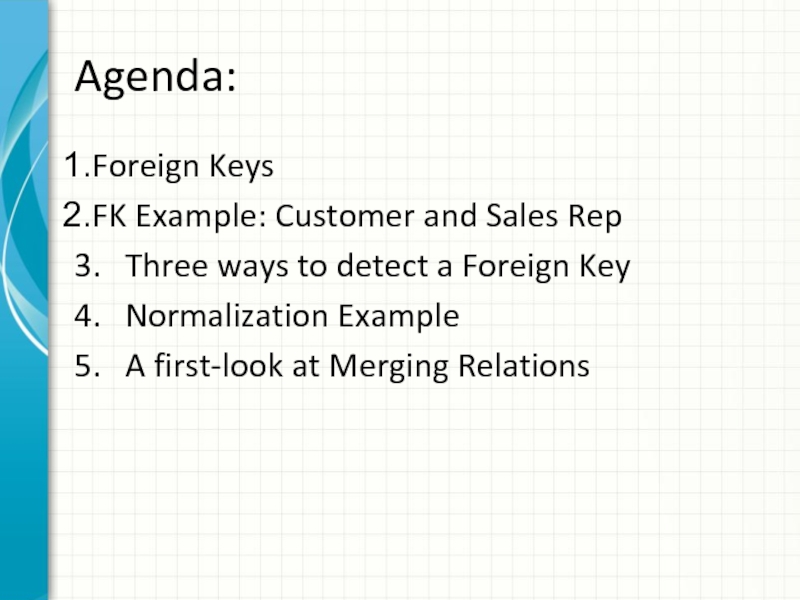
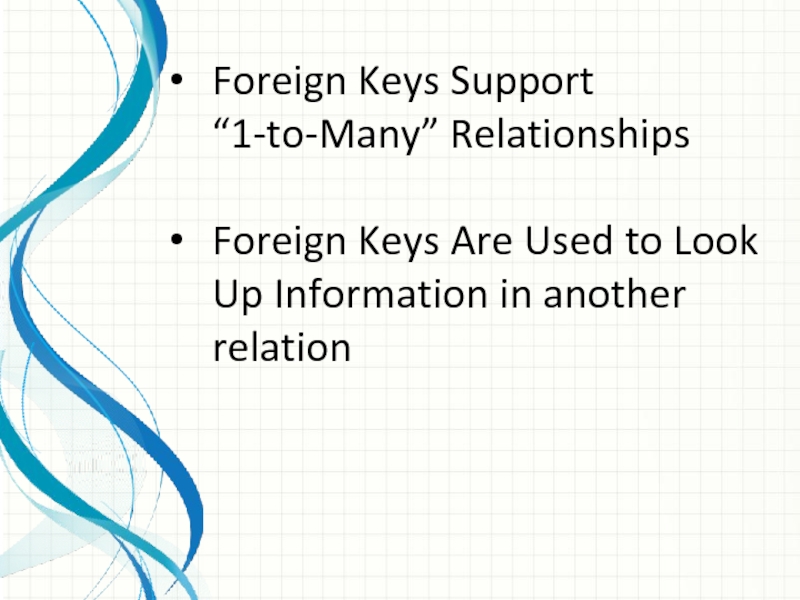
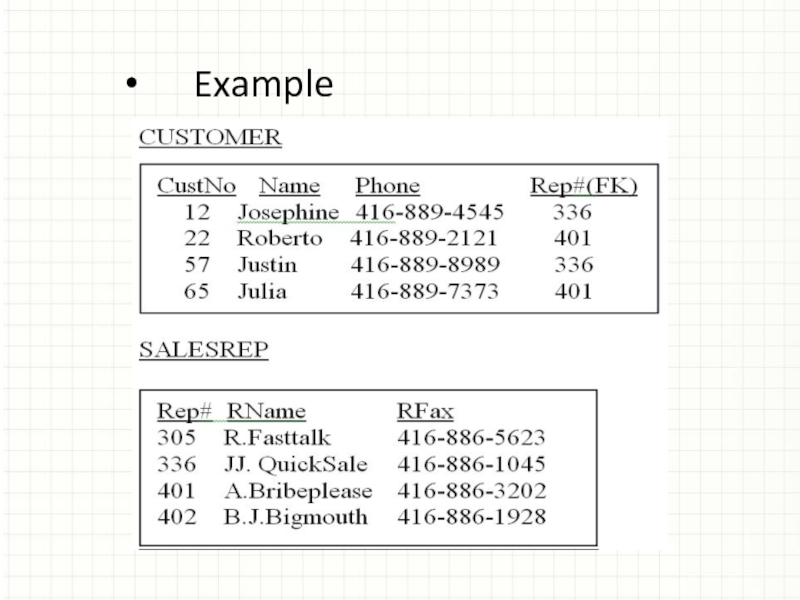
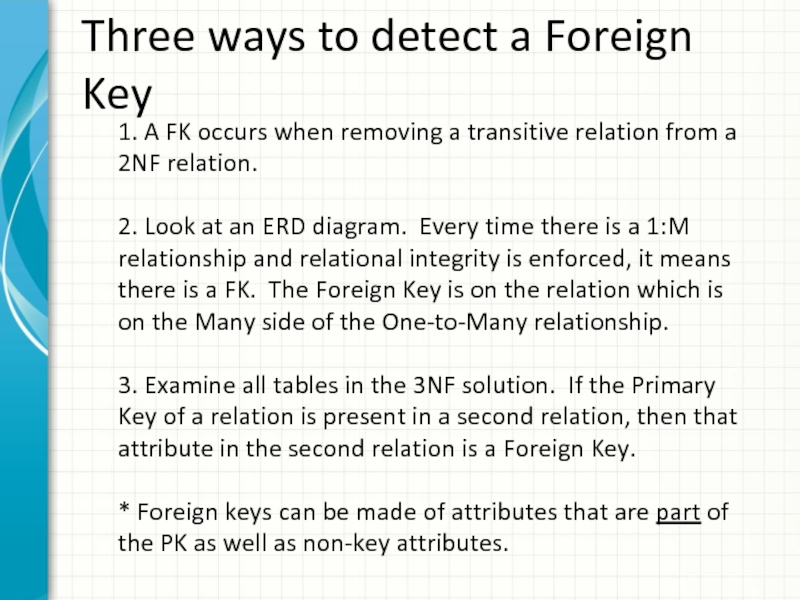

![Normalization Example: ABC PRINTER COMPANYUNF: [ model#, modelDesc, (part#, part_name, qty, suppName, suppPhone, unitPrice) ]](/img/tmb/1/96352/5a1b57a56d2dd8ebf87a20cd7376a7af-800x.jpg)
![Normalization Example: ABC PRINTER COMPANYUNF: [ model#, modelDesc, (part#, part_name, qty, suppName, suppPhone, unitPrice) ] 1NF: MODEL](/img/tmb/1/96352/967cff877843c21f25e88a2dcb796697-800x.jpg)
![Normalization Example: ABC PRINTER COMPANYUNF: [ model#, modelDesc, (part#, part_name, qty, suppName, suppPhone, unitPrice) ] 1NF: MODEL](/img/tmb/1/96352/4756bbbbf88f66c1d8ed47edefe4da33-800x.jpg)
![Normalization Example: ABC PRINTER COMPANYUNF: [ model#, modelDesc, (part#, part_name, qty, suppName, suppPhone, unitPrice) ] 1NF: MODEL](/img/tmb/1/96352/6c6a333501a6b378e7e7ddf4915844ee-800x.jpg)
